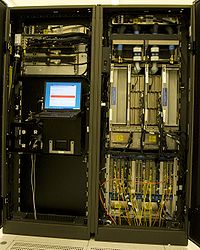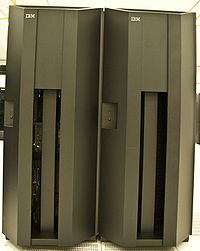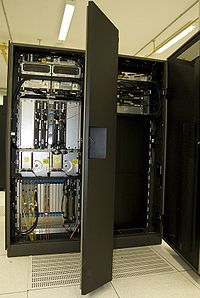
System z9
Encyclopedia




IBM
International Business Machines Corporation or IBM is an American multinational technology and consulting corporation headquartered in Armonk, New York, United States. IBM manufactures and sells computer hardware and software, and it offers infrastructure, hosting and consulting services in areas...
mainframe
Mainframe computer
Mainframes are powerful computers used primarily by corporate and governmental organizations for critical applications, bulk data processing such as census, industry and consumer statistics, enterprise resource planning, and financial transaction processing.The term originally referred to the...
. It was announced on July 25, 2005 and the first models were available on September 16, 2005. The System z9 also marks the end of the previously used eServer
EServer
IBM eServer was a family of computer servers from IBM Corporation.Announced in the year 2000, it combined the various IBM server brands under one brand.The various sub-brands were at the same time rebranded from:...
zSeries
ZSeries
IBM System z, or earlier IBM eServer zSeries, is a brand name designated by IBM to all its mainframe computers.In 2000, IBM rebranded the existing System/390 to IBM eServer zSeries with the e depicted in IBM's red trademarked symbol, but because no specific machine names were changed for...
naming convention, and it is the last z/Architecture 1 (ARCHLVL 2) machine.
Background
System z9 is a mainframe using the z/ArchitectureZ/Architecture
z/Architecture, initially and briefly called ESA Modal Extensions , refers to IBM's 64-bit computing architecture for IBM mainframe computers. IBM introduced its first z/Architecture-based system, the zSeries Model 900, in late 2000. Later z/Architecture systems include the IBM z800, z990, z890,...
, previously known as ESAME. z/Architecture is a 64-bit
64-bit
64-bit is a word size that defines certain classes of computer architecture, buses, memory and CPUs, and by extension the software that runs on them. 64-bit CPUs have existed in supercomputers since the 1970s and in RISC-based workstations and servers since the early 1990s...
architecture which replaces the previous 31-bit
31-bit
Perhaps the only computing architecture based on 31-bit addressing is one of computing's most famous and most profitable. In 1983, IBM introduced 31-bit addressing in the System/370-XA mainframe architecture as an upgrade to the 24-bit addressing of earlier models...
-addressing/32-bit
32-bit
The range of integer values that can be stored in 32 bits is 0 through 4,294,967,295. Hence, a processor with 32-bit memory addresses can directly access 4 GB of byte-addressable memory....
-data ESA/390
ESA/390
ESA/390 was introduced in September 1990 and is IBM's last 31-bit-address/32-bit-data mainframe computing design, copied by Amdahl, Hitachi, and Fujitsu among other competitors...
architecture while remaining completely compatible with it as well as the older 24-bit
24-bit
Notable 24-bit machines include the ICT 1900 series and the Harris H series.The IBM System/360, announced in 1964, was a popular computer system with 24-bit addressing and 32-bit general registers and arithmetic...
-addressing/32-bit
32-bit
The range of integer values that can be stored in 32 bits is 0 through 4,294,967,295. Hence, a processor with 32-bit memory addresses can directly access 4 GB of byte-addressable memory....
-data System/360
System/360
The IBM System/360 was a mainframe computer system family first announced by IBM on April 7, 1964, and sold between 1964 and 1978. It was the first family of computers designed to cover the complete range of applications, from small to large, both commercial and scientific...
architecture. The primary advantage of this arrangement is that intensive applications like DB2
IBM DB2
The IBM DB2 Enterprise Server Edition is a relational model database server developed by IBM. It primarily runs on Unix , Linux, IBM i , z/OS and Windows servers. DB2 also powers the different IBM InfoSphere Warehouse editions...
are no longer bounded by 31-bit memory restrictions while older applications can run without modifications.
Name change
With the announcement of the System z9 Business Class server, IBM has renamed the System z9 109 as the System z9 Enterprise Class server. IBM documentation abbreviates them as the z9 BC and z9 EC, respectively.Notable differences
There are several functional enhancements in the System z9 compared to its zSeries predecessors. Some of the differences include:Support Element & HMC
The Support Element is the most direct and lowest level way to access a mainframe. It circumvents even the Hardware Management ConsoleHardware Management Console
Hardware Management Console is a technology invented by IBM for the purpose of providing a standard interface to configuring and operating partitioned and SMP systems such as IBM System i, IBM System p or IBM Power Systems.The HMC is a Linux kernel using Busybox to provide the base utilities and X...
and the operating system
Operating system
An operating system is a set of programs that manage computer hardware resources and provide common services for application software. The operating system is the most important type of system software in a computer system...
running on the mainframe. The HMC is a PC
IBM PC compatible
IBM PC compatible computers are those generally similar to the original IBM PC, XT, and AT. Such computers used to be referred to as PC clones, or IBM clones since they almost exactly duplicated all the significant features of the PC architecture, facilitated by various manufacturers' ability to...
connected to the mainframe and emulates the Support Element. All preceding zSeries mainframes used a modified version of OS/2
OS/2
OS/2 is a computer operating system, initially created by Microsoft and IBM, then later developed by IBM exclusively. The name stands for "Operating System/2," because it was introduced as part of the same generation change release as IBM's "Personal System/2 " line of second-generation personal...
with custom software to provide the interface. System z9's HMC no longer uses OS/2, but instead uses a modified version of Linux
Linux
Linux is a Unix-like computer operating system assembled under the model of free and open source software development and distribution. The defining component of any Linux system is the Linux kernel, an operating system kernel first released October 5, 1991 by Linus Torvalds...
with an OS/2 lookalike interface to ease transition as well as a new interface. Unlike the previous HMC application on OS/2, the new HMC is web-based which means that even local access is done via a web browser
Web browser
A web browser is a software application for retrieving, presenting, and traversing information resources on the World Wide Web. An information resource is identified by a Uniform Resource Identifier and may be a web page, image, video, or other piece of content...
. Remote HMC access is available, although only over an SSL encrypted HTTP
Hypertext Transfer Protocol
The Hypertext Transfer Protocol is a networking protocol for distributed, collaborative, hypermedia information systems. HTTP is the foundation of data communication for the World Wide Web....
connection. The web-based nature means that there is no longer a difference between local console access and remote access, which means a remote user potentially has full control if authorized, allowing more flexibility for locating systems within data centers. IBM refers to the new HMC as a "closed platform" which does not allow the user to install software or access the command line interface to increase security and stability. The HMC is also firewalled by default with a minimal number of open ports for remote access.
Program Directed Re-IPL
Program Directed Re-IPL is a new feature for Linux on System z9. It allows Linux systems running in an LPARLPAR
A logical partition, commonly called an LPAR, is a subset of computer's hardware resources, virtualized as a separate computer. In effect, a physical machine can be partitioned into multiple logical partitions, each hosting a separate operating system....
to re-IPL (reboot) themselves without operator intervention. This is accomplished by the System z9 storing the device and load parameters used to initially IPL the system.
DB2 and VSAM features
DB2IBM DB2
The IBM DB2 Enterprise Server Edition is a relational model database server developed by IBM. It primarily runs on Unix , Linux, IBM i , z/OS and Windows servers. DB2 also powers the different IBM InfoSphere Warehouse editions...
, VSAM, and other data storage formats achieve greater I/O performance thanks to a new System z9 feature called a MIDAW. Also, the System z9 introduces the zIIP
ZIIP
In IBM System z9 mainframes, the System z Integrated Information Processor is a special purpose processor. It was initially introduced to relieve the general mainframe central processors of specific DB2 processing loads, but currently is used to offload other z/OS workloads as described below...
, a new type of processor that accelerates certain specific DB2 tasks.
Java features
Java 1.4 and higher support both 32-bit32-bit
The range of integer values that can be stored in 32 bits is 0 through 4,294,967,295. Hence, a processor with 32-bit memory addresses can directly access 4 GB of byte-addressable memory....
and 64-bit
64-bit
64-bit is a word size that defines certain classes of computer architecture, buses, memory and CPUs, and by extension the software that runs on them. 64-bit CPUs have existed in supercomputers since the 1970s and in RISC-based workstations and servers since the early 1990s...
operation on z9. The System z9 also supports the zAAP processor, which allows most of the Java workload to be offloaded from the normal instruction processors. Java workloads executed by the zAAP processor do not count towards the IBM-rated capacity of the z9. This reduces the z9's total cost of ownership compared with other platforms. The zAAP also enables integration of new Java based Web applications with core z/OS backend database environment for high performance, reliability, availability, and security.
Cryptography
The System z9 adds 128-Bit Advanced Encryption StandardAdvanced Encryption Standard
Advanced Encryption Standard is a specification for the encryption of electronic data. It has been adopted by the U.S. government and is now used worldwide. It supersedes DES...
(AES) to the list of hardware-based cryptographic algorithms. Other hardware-boosted features include additional random number generation and SHA algorithms. This specialized encryption hardware means System z9 handily outperforms other platforms which must rely on encryption software across a broader range of cryptographic needs.
Additional memory expansion
The System z9 supports twice its immediate predecessors' maximum memory configurations: now up to 512 GB for the z9 EC and up to 64 GB for the z9 BC.Concurrent book replacement
The System z9 supports nondisruptive processor replacement. That means a technician can replace an entire processor bookProcessor book
Memory and processors reside in what are termed books. The book concept was first introduced on the z990 machine of the IBM System z9. A book contains processors, memory, and connection to the I/O cages. Books are located in the CEC cage. Each System z configuration has one to four books....
without ending any applications and without restarting any operating systems. In most configurations a System z9 can even manage this feat without any reduction in performance or capacity for the running applications.
4 Gb FICON and FCP
In May, 2006, IBM added 4 Gigabit FICONFICON
FICON is the IBM proprietary name for the ANSI FC-SB-3 Single-Byte Command Code Sets-3 Mapping Protocol for Fibre Channel protocol. It is a FC layer 4 protocol used to map both IBM’s antecedent channel-to-control-unit cabling infrastructure and protocol onto standard FC services and infrastructure...
and FCP support to the System z9 for faster I/O to storage devices. IBM also added a lower cost 2-port 4 Gb FICON/FCP I/O adapter to the System z9 option list.
Smooth subcapacity increments
Also in May, 2006, IBM introduced subcapacity settings to its high end model. For the first time mainframe processors now allow small, smooth steps through the entire processor range. This feature allows IBM's customers to control their software costs precisely and to pay for only exactly as much capacity as they need without harsh price discontinuities at certain capacity increments. (IBM started offering variable subcapacity software pricing in 2000, and some other software vendors now offer similar terms, so hardware subcapacity settings are of primary interest when running so-called full capacity software products.)Group capacity limits
Available with z/OSZ/OS
z/OS is a 64-bit operating system for mainframe computers, produced by IBM. It derives from and is the successor to OS/390, which in turn followed a string of MVS versions.Starting with earliest:*OS/VS2 Release 2 through Release 3.8...
Release 8, Group Capacity Limits allows an installation to define a group of LPARs within a single z9 or z10 machine whose capacity usage can be limited to a specific number of MSUs. Usage is based on the rolling 4 hour average CPU consumption, also in MSUs. A group need not necessarily be the same as an LPAR Cluster. LPARs can participate whether they are in a sysplex or not.
Separate Processor Pools
While previous mainframe generations (including the predecessor zSeriesZSeries
IBM System z, or earlier IBM eServer zSeries, is a brand name designated by IBM to all its mainframe computers.In 2000, IBM rebranded the existing System/390 to IBM eServer zSeries with the e depicted in IBM's red trademarked symbol, but because no specific machine names were changed for...
z990) supported specialty processors, such as zAAPs and ICFs, these were all managed by PR/SM out of the same processor pool (Pool 2). The IBM System z9 EC introduced the concept of separate pools for different types of specialty processor. This greatly eases the tasking of managing and measuring the performance of the different processor types. With z9 (and IBM System z10
IBM System z10
IBM System z10 is a line of IBM mainframes. The z10 Enterprise Class was announced on February 26, 2008. On October 21, 2008, IBM announced the z10 Business Class , a scaled down version of the z10 EC...
) the following pools are defined:
- 1 General Purpose Processors
- 3 IFLs
- 4 zAAPs
- 5 ICFs
- 6 zIIPs
Pool 2 is no longer used.
In addition to these 5 pools of characterized processors, there are three other categories of processor:
- Service Assist Processors (for assisting with I/O operations) which all machines have.
- Spare processors (to replace characterized processors in the event of a failure) which all machines have.
- Unpurchased processors (which can be purchased and then characterized) which all but the most fully characterized machines have.
Enterprise Class
The System z9 Enterprise Class server, formerly known as the System z9 109, was the flagship of the System z9 series until the announcement of the IBM System z10IBM System z10
IBM System z10 is a line of IBM mainframes. The z10 Enterprise Class was announced on February 26, 2008. On October 21, 2008, IBM announced the z10 Business Class , a scaled down version of the z10 EC...
. The most powerful model, the 2094-S54, achieves approximately twice the transactional performance of its most powerful predecessor, the zSeries z990 (2084-332). A single 2094-S54 machine provides up to 54 main processors (plus scores of secondary processors), at least two spare main processors, and up to 512 GB of main memory. Minimum memory is 16 GB.
The System z9 EC is available in five hardware model configurations:
- 2094-S08
- 2094-S18
- 2094-S28
- 2094-S38
- 2094-S54
Business Class
On April 27, 2006, IBM announced the System z9 Business Class, also known as the z9 BC, as the successor to the zSeries z890 mainframe. IBM is positioning the z9 BC as a midrange system with a low cost of acquisition with up to twice the performance of the z890. The first z9 BCs began shipping on May 26, 2006. The z9 BC supports up to seven main processors (plus a dozen or more secondary processors). While the z9 BC can provide general purpose central processors (CPs), IBM is actively marketing the use of low cost specialty processors such as IFLs, zAAPs, and the new zIIPs. (Every z9 BC can support at least three specialty engines even when maximally configured with CPs.) The z9 BC comes with a minimum of 8 GB of RAM and is expandable up to 64 GB. IBM offers kits that allow current z800 and z890 customers to upgrade to the z9 BC. A z9 BC customer can then upgrade to the z9 EC if extra capacity is required.The System z9 BC is available in two hardware model configurations:
- 2096-R07
- 2096-S07
The seven System z9 hardware configurations support scores of software model configurations: 2094-401 through 2094-754 for the EC and 2096-A01 through 2096-Z04 for the BC (plus IFL-only models).
Pricing
The acquisition price for the System z9 ranges from "about $100,000" (IBM reported U.S. 2006 price, 2096-A01 model) to millions of dollars for the 2094-S54. (These prices are for new installations. Generally there are lower prices when upgrading from the immediate predecessor model, more like many software products and quite unlike most other hardware products.) For comparison, when new, the zSeries z890 had a starting price about twice that of the System z9 BC.Successor machine
In February, 2008, the IBM System z10IBM System z10
IBM System z10 is a line of IBM mainframes. The z10 Enterprise Class was announced on February 26, 2008. On October 21, 2008, IBM announced the z10 Business Class , a scaled down version of the z10 EC...
Enterprise Class was announced (and later in 2008 the z10 Business Class (BC) was announced). The z10 features quad-core technology, for up to 64 processors. The z10 has a number of power-saving, space-saving and throughput improvements compared to the z9.

